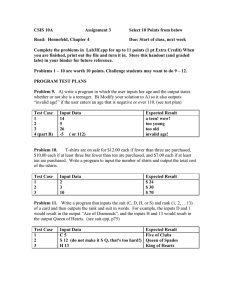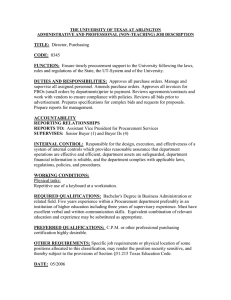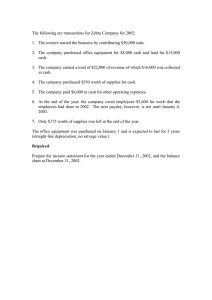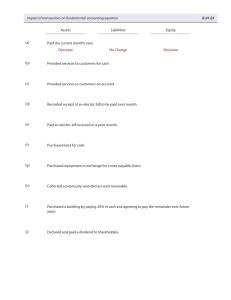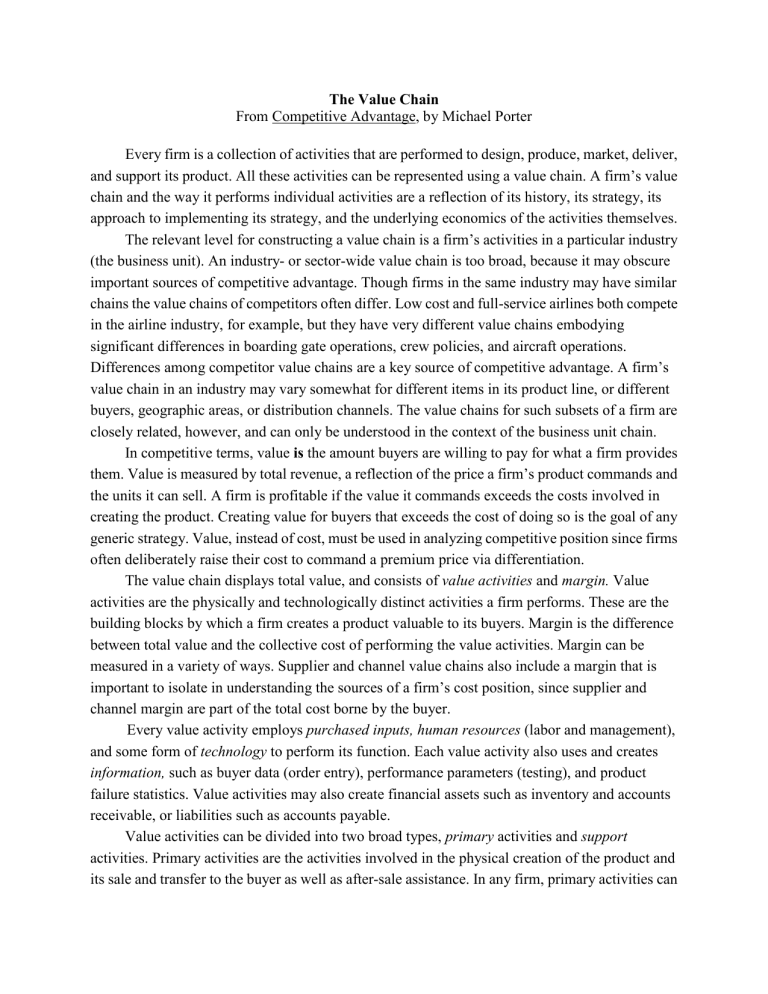
The Value Chain From Competitive Advantage, by Michael Porter Every firm is a collection of activities that are performed to design, produce, market, deliver, and support its product. All these activities can be represented using a value chain. A firm’s value chain and the way it performs individual activities are a reflection of its history, its strategy, its approach to implementing its strategy, and the underlying economics of the activities themselves. The relevant level for constructing a value chain is a firm’s activities in a particular industry (the business unit). An industry- or sector-wide value chain is too broad, because it may obscure important sources of competitive advantage. Though firms in the same industry may have similar chains the value chains of competitors often differ. Low cost and full-service airlines both compete in the airline industry, for example, but they have very different value chains embodying significant differences in boarding gate operations, crew policies, and aircraft operations. Differences among competitor value chains are a key source of competitive advantage. A firm’s value chain in an industry may vary somewhat for different items in its product line, or different buyers, geographic areas, or distribution channels. The value chains for such subsets of a firm are closely related, however, and can only be understood in the context of the business unit chain. In competitive terms, value is the amount buyers are willing to pay for what a firm provides them. Value is measured by total revenue, a reflection of the price a firm’s product commands and the units it can sell. A firm is profitable if the value it commands exceeds the costs involved in creating the product. Creating value for buyers that exceeds the cost of doing so is the goal of any generic strategy. Value, instead of cost, must be used in analyzing competitive position since firms often deliberately raise their cost to command a premium price via differentiation. The value chain displays total value, and consists of value activities and margin. Value activities are the physically and technologically distinct activities a firm performs. These are the building blocks by which a firm creates a product valuable to its buyers. Margin is the difference between total value and the collective cost of performing the value activities. Margin can be measured in a variety of ways. Supplier and channel value chains also include a margin that is important to isolate in understanding the sources of a firm’s cost position, since supplier and channel margin are part of the total cost borne by the buyer. Every value activity employs purchased inputs, human resources (labor and management), and some form of technology to perform its function. Each value activity also uses and creates information, such as buyer data (order entry), performance parameters (testing), and product failure statistics. Value activities may also create financial assets such as inventory and accounts receivable, or liabilities such as accounts payable. Value activities can be divided into two broad types, primary activities and support activities. Primary activities are the activities involved in the physical creation of the product and its sale and transfer to the buyer as well as after-sale assistance. In any firm, primary activities can be divided into the five generic categories. (Handout) Support activities support the primary activities and each other by providing purchased inputs, technology, human resources, and various firm-wide functions. The dotted lines reflect the fact that procurement, technology development, and human resource management can be associated with specific primary activities as well as support the entire chain. Firm infrastructure is not associated with particular primary activities but supports the entire chain. Value activities are therefore the discrete building blocks of competitive advantage. How each activity is performed combined with its economics will determine whether a firm is high or low cost compared to competitors. How each value activity is performed will also determine its contribution to buyer needs and hence differentiation. Comparing the value chains of competitors exposes differences that determine competitive advantage. An analysis of the value chain rather than value added is the appropriate way to examine competitive advantage. Value added (selling price less the cost of purchased raw materials) has sometimes been used as the focal point for cost analysis because it was viewed as the area in which a firm can control costs. Value added is not a sound basis for cost analysis, however, because it incorrectly distinguishes raw materials from the many other purchased inputs used in a firm’s activities. Also, the cost behavior of activities cannot be understood without simultaneously examining the costs of the inputs used to perform them. Moreover, value added fails to highlight the linkages between a firm and its suppliers that can reduce cost or enhance differentiation. Identifying Value Activities Identifying value activities requires the isolation of activities that are technologically and strategically distinct. Value activities and accounting classifications are rarely the same. Accounting classifications (e.g., burden, overhead, direct labor) group together activities with disparate technologies, and separate costs that are all part of the same activity. PRIMARY ACTIVITIES There are five generic categories of primary activities involved in competing in any industry. Each category is divisible into a number of distinct activities that depend on the particular industry and firm strategy: • Inbound Logistics. Activities associated with receiving, storing, and disseminating inputs to the product, such as material handling, warehousing, inventory control, vehicle scheduling, and returns to suppliers. • Operations. Activities associated with transforming inputs into the final product form, such as machining, packaging, assembly, equipment maintenance, testing, printing, and facility operations. • Outbound Logistics. Activities associated with collecting, storing, and physically distributing the product to buyers, such as finished goods warehousing, material handling, delivery vehicle operation, order processing, and scheduling. • Marketing and Sales. Activities associated with providing a means by which buyers can purchase the product and inducing them to do so, such as advertising, promotion, sales force, quoting, channel selection, channel relations, and pricing. • Service. Activities associated with providing service to enhance or maintain the value of the product, such as installation, repair, training, parts supply, and product adjustment. Each of the categories may be vital to competitive advantage depending on the industry. For a distributor, inbound and outbound logistics are the most critical. For a service firm providing the service on its premises such as a restaurant or retailer, outbound logistics may be largely nonexistent and operations the vital category. For a bank engaged in corporate lending, marketing and sales are a key to competitive advantage through the effectiveness of the calling officers and the way in which loans are packaged and priced. For a high-speed copier manufacturer, service represents a key source of competitive advantage. In any firm, however, all the categories of primary activities will be present to some degree and play some role in competitive advantage. Support Activities Support value activities involved in competing in any industry can be divided into four generic categories. As with primary activities, each category of support activities is divisible into a number of distinct value activities that are specific to a given industry. In technology development, for example, discrete activities might include component design, feature design, field-testing, process engineering, and technology selection. Similarly, procurement can be divided into activities such as qualifying new suppliers, procurement of different groups of purchased inputs, and ongoing monitoring of supplier performance. Procurement. Procurement refers to the function of purchasing inputs used in the firm’s value chain, not to the purchased inputs themselves. Purchased inputs include raw materials, supplies, and other consumable items as well as assets such as machinery, laboratory equipment, office equipment, and buildings. Though purchased inputs are commonly associated with primary activities, purchased inputs are present in every value activity including support activities. For example, laboratory supplies and independent testing services are common purchased inputs in technology development, while an accounting firm is a common purchased input in firm infrastructure. Like all value activities, procurement employs a “technology,” such as procedures for dealing with vendors, qualification rules, and information systems. Procurement tends to be spread throughout a firm. Some items such as raw materials are purchased by the traditional purchasing department, while other items are purchased by plant managers (e.g., machines), office managers (e.g., temporary help), salespersons (e.g., meals and lodging), and even the chief executive officer (e.g., strategic consulting). I use the term procurement rather than purchasing because the usual connotation of purchasing is too narrow among managers. The dispersion of the procurement function often obscures the magnitude of total purchases, and means that many purchases receive little scrutiny. A given procurement activity can normally be associated with a specific value activity or activities which it supports, though often a purchasing department serves many value activities and purchasing policies apply firm-wide. The cost of procurement activities themselves usually represents a small if not insignificant portion of total costs, but often has a large impact on the firm’s overall cost and differentiation. Improved purchasing practices can strongly affect the cost and quality of purchased inputs, as well as of other activities associated with receiving and using the inputs, and interacting with suppliers. In chocolate manufacturing and electric utilities, for example, procurement of cocoa beans and fuel respectively is by far the most important determinant of cost position. Technology Development. Every value activity embodies technology, be it know-how, procedures, or technology embodied in process equipment. The array of technologies employed in most firms is very broad, ranging from those technologies used in preparing documents and transporting goods to those technologies embodied in the product itself. Moreover, most value activities use a technology that combines a number of different subtechnologies involving different scientific disciplines. Machining, for example, involves metallurgy, electronics, and mechanics. Technology development consists of a range of activities that can be broadly grouped into efforts to improve the product and the process. I term this category of activities technology development instead of research and development because R&D has too narrow a connotation to most managers. Technology development tends to be associated with the engineering department or the development group. Typically, however, it occurs in many parts of a firm, although this is not explicitly recognized. Technology development may support any of the numerous technologies embodied in value activities, including such areas as telecommunications technology for the order entry system, or office automation for the accounting department. It does not solely apply to technologies directly linked to the end product. Technology development also takes many forms, from basic research and product design to media research, process equipment design, and servicing procedures. Technology development that is related to the product and its features supports the entire chain, while other technology development is associated with particular primary or support activities. Technology development is important to competitive advantage in all industries, holding the key in some. In steel, for example, a firm’s process technology is the single greatest factor in competitive advantage. Human Resource Management. Human resource management consists of activities involved in the recruiting, hiring, training, development, and compensation of all types of personnel. Human resource management supports both individual primary and support activities (e.g., hiring of engineers) and the entire value chain (e.g., labor negotiations). Human resource management activities occur in different parts of a firm, as do other support activities, and the dispersion of these activities can lead to inconsistent policies. Moreover, the cumulative costs of human resource management are rarely well understood nor are the tradeoffs in different human resource management costs, such as salary compared to the cost of recruiting and training due to turnover. Human resource management affects competitive advantage in any firm, through its role in determining the skills and motivation of employees and the cost of hiring and training. In some industries it holds the key to competitive advantage. The world’s leading accounting firm Arthur Andersen, for example, draws a significant competitive advantage from its approach to recruiting and training its tens of thousands of professional staff. Arthur Andersen has bought a former college campus near Chicago, and has invested heavily in codifying its practice and regularly bringing staff from around the world to its college for training in the firm-wide methodology. Having a deeply understood methodology throughout the firm not only makes all engagements more effective but also greatly facilitates the servicing of national and multinational clients. Firm Infrastructure. Firm infrastructure consists of a number of activities including general management, planning, finance, accounting, legal, government affairs, and quality management. Infrastructure, unlike other support activities, usually supports the entire chain and not individual activities. Depending on whether a firm is diversified or not, firm infrastructure may be self-contained or divided between a business unit and the parent corporation. In diversified firms, infrastructure activities are typically split between the business unit and corporate levels (e.g., financing is often done at the corporate level while quality management is done at the business unit level). Many infrastructure activities occur at both the business unit and corporate levels, however. Firm infrastructure is sometimes viewed only as “overhead,” but can be a powerful source of competitive advantage. In a telephone operating company, for example, negotiating and maintaining ongoing relations with regulatory bodies can be among the most important activities for competitive advantage. Similarly, proper management information systems can contribute significantly to cost position, while in some industries top management plays a vital role in dealing with the buyer. Defining the Value Chain To diagnose competitive advantage, it is necessary to define firm’s value chain for competing in a particular industry. Starting with the generic chain, individual value activities are identified in the particular firm. Each generic category can be divided into discrete activities. Defining relevant value activities requires that activities with discrete technologies and economics be isolated. Broad functions such as manufacturing or marketing must be subdivided into activities. The product flow, order flow or paper flow can be useful in doing so. Subdividing activities can proceed to the level of increasingly narrow activities that are to some degree discrete. Every machine in a factory, for example, could be treated as a separate activity. Thus the number of potential activities is often quite large. The appropriate degree of disaggregation depends on the economics of the activities and the purposes for which the value chain is king analyzed. Though I will return to this question in later chapters, the basic principle is that activities should be isolated and separated that: (1) have different economics, (2) have a high potential impact of differentiation, or (3) represent a significant or growing proportion of cost. In using the value chain, successively finer disaggregations of some activities are made as the analysis exposes differences important to competitive advantage; other activities are combined because they prove to be unimportant to competitive advantage or are governed by similar economics. Selecting the appropriate category in which to put an activity may require judgment and can be illuminating in its own right. Order processing, for example, could be classified as part of outbound logistics or as part of marketing. In a distributor, the role of order processing more is more a marketing function. Similarly, the sales force often performs service functions. Value activities should be assigned to categories that best represent their contribution to a firm’s competitive advantage. If order processing is an important way in which a firm interacts with its buyers, for example, it should be classified under marketing. Similarly, if inbound material handling and outbound material handling use the same facilities and personnel, then both should probably be combined into one value activity and classified wherever the function has the greatest competitive impact. Firms have often gained competitive advantage by redefining the roles of traditional activities—Vetco, an oil field equipment supplier, uses customer training as a marketing tool and a way to build switching costs, for example. Everything a firm does should be captured in a primary or support activity. Value activity labels are arbitrary and should be chosen to provide the best insight into the business. Labeling activities in service industries often causes confusion because operations, marketing, and after-sale support are often closely tied. Ordering of activities should broadly follow the process flow, but ordering is judgmental as well. Often firms perform parallel activities, whose order should be chosen to enhance the intuitive clarity of the value chain to managers.

